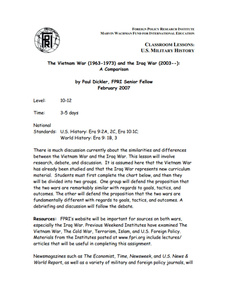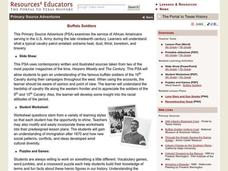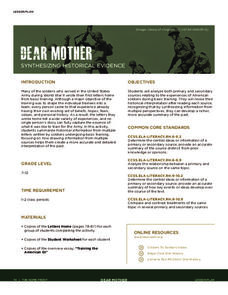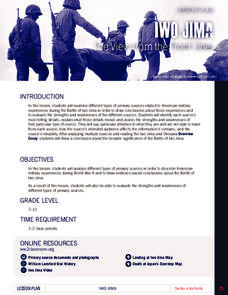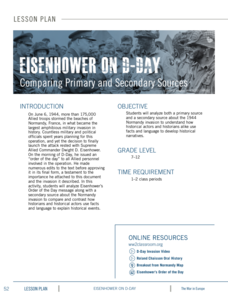American Battlefield Trust
1862: Antietam and Emancipation
Was the Emancipation Proclamation a revolutionary document or just a military strategy? It proclaimed that all those enslaved in Confederate states would be "forever free." Logistically, though, it did little. The order, however,...
Roy Rosenzweig Center for History and New Media
George Washington: General, President, Slave Owner
Times change; behaviors that were once considered acceptable can be seen in a very different light. Middle schoolers revisit the legacy of George Washington in a three-day lesson plan that uses primary sources to reveal Washington as a...
Curated OER
Defend the Alamo
Students analyze a diagram of the Alamo from a military perspective and list reasons why it was so hard to defend. They work in small groups to find ways that William Travis could have make it more defensible.
Foreign Policy Research Institute
The Vietnam War (1963-1973) and the Iraq War (2003---): A Comparison
If you are planning a unit on military history that includes a comparison between the Vietnam War and the Iraq War, this resource may be useful. It lists possible sources for pupils to use to complete the graphic organizer which prepares...
Curated OER
Soldiers' Stories
Students share opinions about the conditions under which they might risk their lives for a cause. They write letters from the perspective of soldiers and family members during a tour of duty.
Curated OER
Launching the New U.S. Navy
Students analyze United States Constitution, locate general references to common defense, and specific references in document to U.S. Navy. Students then respond to questions on Document Analysis Worksheet, and discuss relationship...
Curated OER
Buffalo Soldiers
Fourth graders explore the role of the buffalo soldiers in the United States Army during the nineteenth century conflict along the frontier with the Indian tribes. They discuss the social change represented by African Americans serving...
Curated OER
Iraq's Latest Strategy: Suicide Attacks
This discussion based lesson focuses on the sensitive topic of suicide attacks or bombings used throughout history during times of militaristic upheaval. Learners read news stories, compose journal entries, and engage in a class...
Curated OER
Combat Credentials
Students examine the connection between military experiences and presidential campaigns, reading "A War is Nice on the Resume, But It May Not Get You the Job." students research an American president's background and create a...
Curated OER
Bennington Battlefield
Learners explore the characteristics of the area around the battlefield and the groups who participated on both sides of the battle. The relative importance of manpower, motivation, and leadership in the outcome of a military conflict is...
Curated OER
And Justice For All
Students compare three justice systems currently in place in the United States: the civilian criminal justice system, the military criminal justice system (courts-martial) and the secret wartime tribunals that President Bush has proposed...
Curated OER
War Games
Students examine the issues outlined in Vice President Cheney's speech about potential United States military action against Iraq, then participate in a role-play activity.
Curated OER
The Battle of Corydon
Fourth graders study the Battle of Corydon, its military leaders, and its influence on the town. In this Battle of Corydon lesson plan, 4th graders develop vocabulary needed to complete the lesson plan, listen as the teacher reads The...
National Endowment for the Humanities
How to Win a World War
High schoolers are have begun to learn the art of diplomacy with each other, but do they understand how diplomacy works at a global level? The second in a series of four lessons, guides scholars in evaluating primary sources. The why...
Syracuse University
Civil War
What was it like to enlist as a soldier in the Civil War? By using enlistment papers, young scholars consider this question. After they've looked at the primary source and discussed it, they create a short story of a fictional soldier to...
National WWII Museum
Dear Mother: Synthesizing Historical Evidence
It's one thing to read history, it's another to live it. Pupils examine secondary and primary sources that detail the training of soldiers before deployment. Then, they consider the impact of primary sources on how they understand the...
Center for History Education
Who Fired the Shot Heard Round the World?
Take a closer look. Young academics become detectives in an engaging lesson on the American Revolution. Scholars work in groups to analyze documents to uncover whether the American colonists or British soldiers fired the first shot at...
Center for History Education
Fighting for Whose Freedom? Black Soldiers in the American Revolution
Fight for freedom! The lesson delves into the world of African American soldiers during the American Revolution. Scholars read documents, such as the Dunmore Proclamation, to understand how the British government treated African...
Center for History Education
The Cuban Missile Crisis
Cold War tensions led to hostile actions. Scholars use primary sources to understand the Bay of Pigs and the Cuban Missile Crisis during President Kennedy's administration. The instructional activity provides primary sources and a...
National WWII Museum
Evaluating the US Decision to Drop the Atomic Bombs
While the use of the atomic bomb was the definitive end of World War II, the terrible weapons left new questions. Young scholars use primary sources and analytical worksheets to consider the implications of the fateful decision. Then,...
National WWII Museum
Iwo Jima: The View from the Front Lines
Iwo Jima was the site of some of the most grim fighting in World War II. Learners consider this fact while examining primary sources, including letters home, from those on the front lines. After they complete the analysis, scholars then...
National WWII Museum
Eisenhower on D-Day: Comparing Primary and Secondary Sources
Dwight D. Eisenhower's message to troops for D-Day is iconic. Individuals examine Eisenhower's words and compare that to historians' understanding of the epic events of that day using primary sources, an essay, and a Venn diagram to...
National WWII Museum
The Red Ball Express: Statistics as Historical Evidence
Historians use all kinds of information to make conclusions ... including statistics. Young scholars examine how two historians evaluate The Red Ball Express—a supply line staffed primarily by African Americans—using numbers. The...
American Battlefield Trust
Jeremiah Handley
Designed for middle school scholars, a instructional activity explores the life of Jeremiah Handley, a young man when the Civil War broke out. Pupils read Handley's personal story, accounts of battles, and view images to understand what...
Other popular searches
- Military History
- Military Officers
- Military Schools
- Ancient Military History
- United States Military History
- Military Resources
- Military Science
- Military Draft
- Military History Texas
- Military Service
- Military Maps
- American Military History





